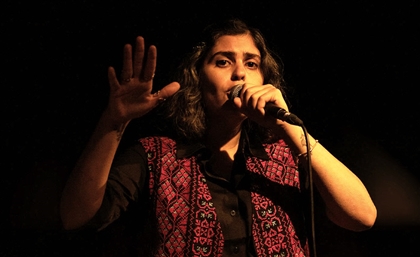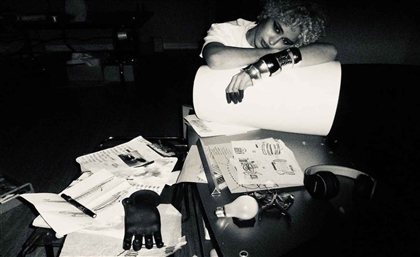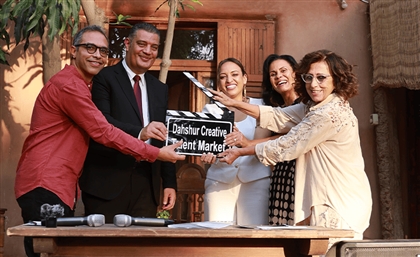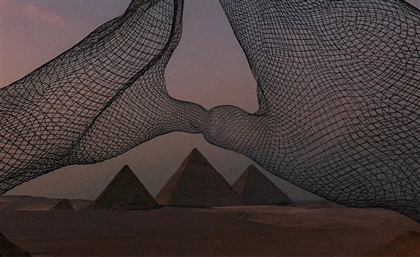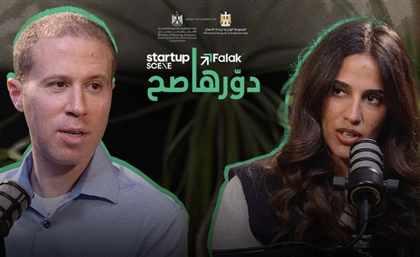SceneNoise x Hiya Dialogues: Nancy Mounir
Lebanese journalist, programmer and DJ Shirine Saad sits with Egyptian composer Nancy Mounir, to discuss microtonality, the birth of ‘Nozhat El Nofos’ and healing through sound.

In a time where the future of microtonal music is questioned, Egyptian multi-instrumentalist, arranger, and composer Nancy Mounir is summoning an older generation of musical rebels and crafting sonic dialogues with archival recordings to shed light on the nearly-extinct rich rhythms from before the standardisation of Arabic maqam. Arguably a pioneering figure in revitalising microtonal music, Mounir explores the techniques and perspectives of a more freewheeling period in Arabic music, with a liberating attitude of defiance.
Born in Alexandria into a musically inclined household with her parents playing in the church choir, Mounir started experimenting with different instruments as a kid—from her thrifted three-string guitar to her mother’s flute recorder and her father’s accordion and mandolin. Her unwavering passion for microtonality stemmed from her boredom with the linearity of mainstream music. And, though she didn’t have a formal academic education in music, she had the freedom of navigation propelling her on a journey of self-education, where she’d shadow various musicians and artists from different backgrounds—Fer2et El Warsha, the Zaar group Mazaher, and Dina El Wedidi—and observe their creative approaches and techniques.
Mounir is globally recognized for her masterpiece ‘Nozhat El Nofos’, a remarkable communion with ghosts, where Mounir explores the microtonality, non-metered rhythms and bold vulnerability of archival recordings from the 20th century, creating a hauntingly intriguing sound that is both warmly familiar and utterly new.
In this episode of SceneNoise x Hiya Dialogues, Lebanese Arts journalist, programmer and DJ, Shirine Saad sit down with Nancy Mounir, uncovering how she started exploring different instruments and genres—from sacred music to maqamat and zaar—, why she fell in love with microtonality, the birth story of her masterpiece ‘Nozhat El Nofos’, and healing through sound and community collaborations.
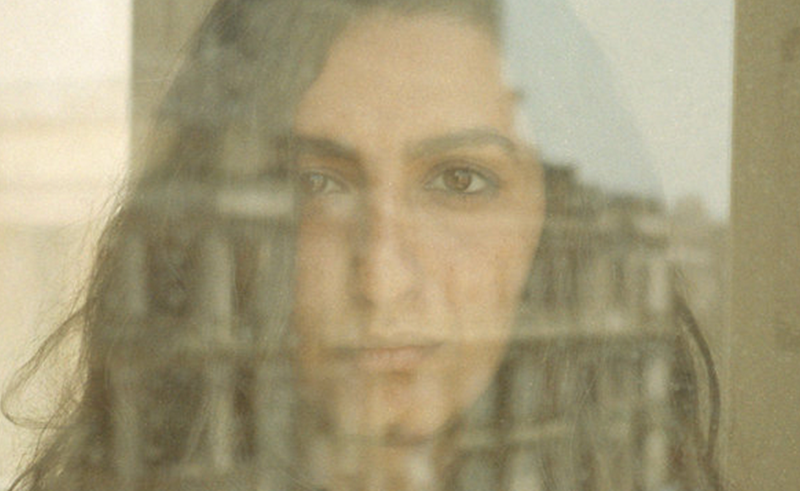
SceneNoise x Hiya Dialogues is a series conducted by Shirine Saad as part of their PhD multimedia project, highlighting radical feminist voices and influential artists from the SWANA underground scene, who are actively engaging with historical revolutionary movements to challenge the cis-heteropatriarchal and capitalist structures within the industry through their art, music and poetry.
‘’These interviews are a continuation of an academic research project I started 10 years ago, digging deeper into the history of the region—from Mesopotamia to Ancient Egypt and the 20th Century Arab world—to highlight radical feminist voices whose artistic endeavours are challenging the male-centric perspective on the industry and musical aesthetics’’ Shirine Saad tell SceneNoise.
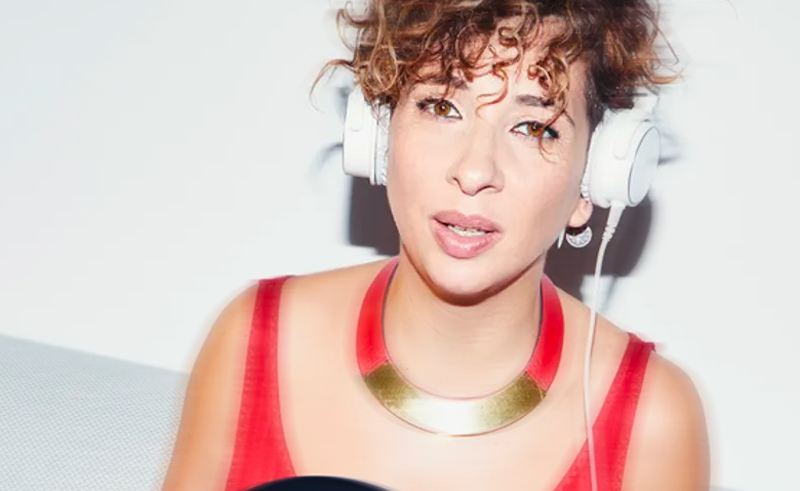 Image by Eva Sakellarides
Image by Eva Sakellarides
How did you start playing with all of these different instruments?
It started when I was very young. My brother and I used to experiment a lot. We’d get different objects, like a tricycle, for example, and make it our drum kit. We also had a guitar that we bought from a flea market with only three strings, so we used to play with the tuning. There was also a piano at the church we used to go to, where my brother eventually started playing bass. Besides that, my mother had a flute recorder and my father had a mandoline and an accordion. So, I was lucky enough to find myself surrounded by different instruments since I was a kid.
What kind of music did you grow up listening to?
I used to listen to the radio a lot because it was very convenient and I could sneak it into my room or under my pillow. Back then, there was the European local service of Cairo radio, which would broadcast different kinds of music from different countries. Every day there would be a different country takeover, introducing you to the music of that country. There was also a Jazz program on Sunday night, and past midnight I would switch the channel and listen to the broadcasting of theatre plays.
That’s really interesting because when you think about it, you didn’t necessarily have a music scene around you at the time like the one we have today, right?
Not really. Or maybe if there was back then, I wasn’t really exposed to it. But, I was mainly playing music at church. And my father used to travel a lot and get us tapes and CDs from the countries he’d go to, like Tunisia or anywhere else he’d been. So, I was exposed to the music he was listening to.
I was also not really connected to all the mainstream pop Egyptian songs, except a few. My parents were in the church choir, and I was mainly listening to classical music. I became so aware of the fact that harmony is one of my main sources of pleasure. I was so into that.
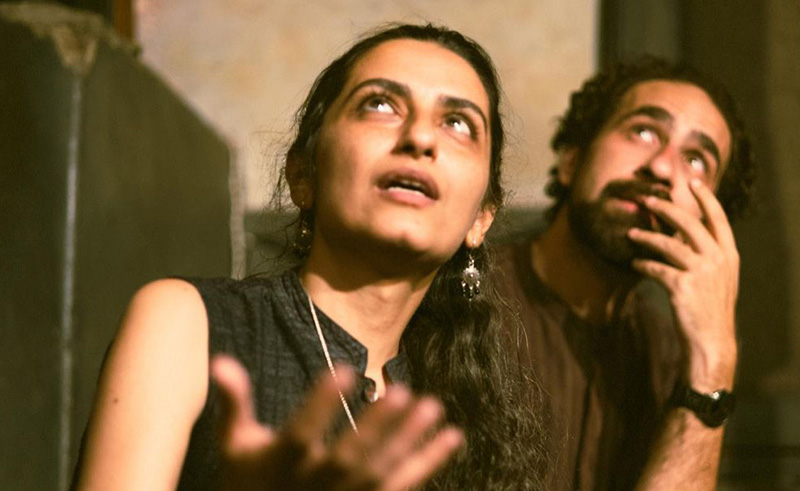 Image by Kafrawy
Image by Kafrawy
You worked in theatre as well as in different kinds of music. How did you start performing with your brother, exploring all these different areas and developing your own style at the end?
I think one of the things that was helpful for us when we were kids was church. You know when your play was very rubbish and then everybody tells you God bless you at the end? I think that kind of gave us a lot of encouragement to do what we wanted to do.
Although I was so angry at that time that I didn’t have the chance to study music academically, I recently realised that it’s also a blessing in a way because it gave me a certain amount of freedom to explore and create without having that classical upbringing and all its rigid ways of thinking.
How did you develop your own perspective on music without being trained academically?
Being in the theatre group in my church. It was more like a space to try and explore things with other people. In 2005, when the Library of Alexandria was open again and they had theatres for young people to practise their music, I met a lot of amazing musicians like the guys from Masar Egbari and the metal band Scar [Massive Scar Era]. Then, Fathy Salama started to come to Alexandria to give us workshops. So, it was a very important moment for me because I got to meet musicians outside the church bubble that I was growing up in.
How was that like for you—to really start expanding into all these different styles and collaborate with all these artists from different backgrounds and with different perspectives?
It was very interesting, especially since I was very open to collaborations and learning, even from projects that I didn’t like so much. I loved collaborating in terms of session musicians because then I’d observe other people making music. I got to see why they liked it this way or why they didn’t like it that way. It taught me a lot about the elements of music and gave me a lot of space to analyse things and figure things out. Through it, I started asking questions that led me to the archives you know.
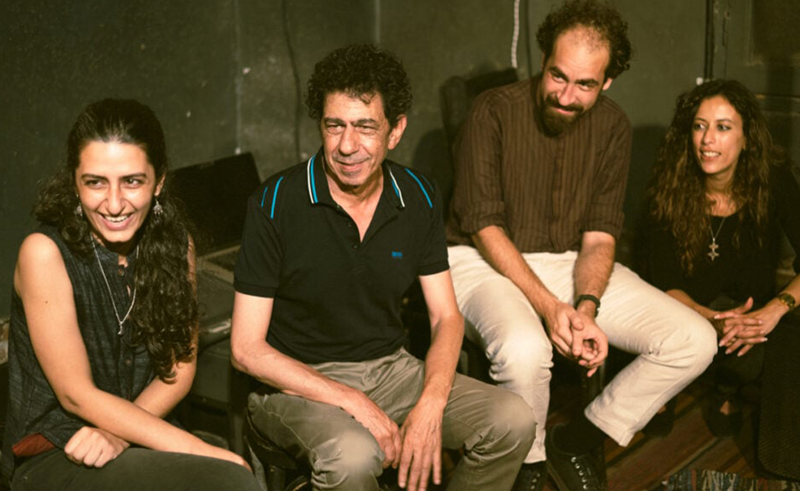 Image by Kafrawy
Image by Kafrawy
Are your passions archives, learning and rediscovering history?
Yeah, that journey of exploring these territories started from very simple questions like “Why is it that I’m not very connected to Egyptian pop or very traditional music?”, and “Why do I like things with harmony like this?”
When I was young, playing as a sessionist in all these amazing projects, I didn’t find so much pleasure in the linearity of classical music. I was always thinking, “Why are things very predictable?”, “Why are we stuck to these four chords?”, and “Why are all of these musicians with Umm Kulthum playing the same notes?”
Then, when Kamilya [Jubran] introduced us to songs from the 1920s, before the standardisation that came with the 1932 Congress, I discovered the beauty of microtonality. Before that, I was also lucky to meet with Dina El Wedidi at one of Fathy Salama’s workshops, and I was so fascinated with the way she composed with very irregular rhythms, a lot of microtonality and with her authentic heritage at the back of her mind. All without studying composition. I see her as one of the most amazing composers because she is connected to her roots and honours traditional music.
I was also fortunate to meet with Fer2et El Warshah and explore things through them because they have that repertoire of ‘El Sera El Elahya’ and all the old, and nicer pop historical material. And, then when I hung out with Mazaher, a very interesting Zaar group, I got to see how different their music is and how they think and talk about music differently. I decided to delve deeper into their melody and learn how to play microtones myself.
So, trying to get out of that boredom I felt led me on this weird journey. It was mainly coming from a place of trying to become a better musician, and because of my lack of formal education in music, this was my way of basically trying to educate myself. By hanging out with different musicians like them and noticing their approach to music.
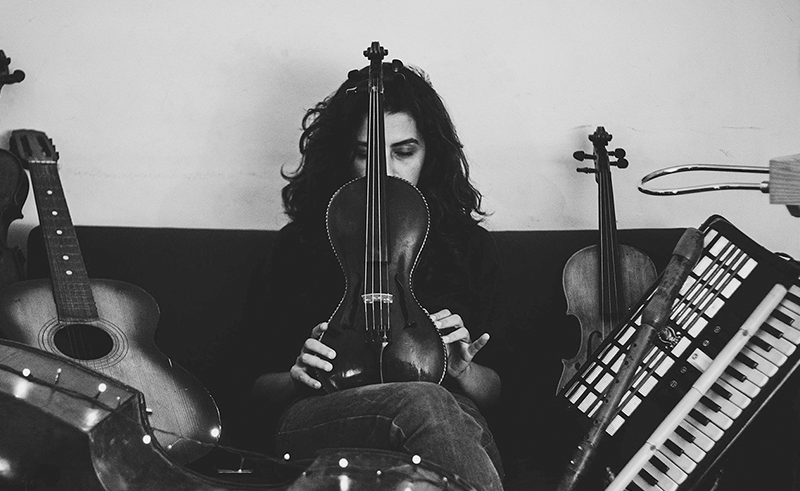 Could you explain to the people who don’t know music, what microtonality is, and why is it important to reenter this aspect in musical compositions and performances?
Could you explain to the people who don’t know music, what microtonality is, and why is it important to reenter this aspect in musical compositions and performances?
So, in Egypt especially, every city or village has its own special music and its own tuning system or organic interpretations and development of their ritual practices in songs. For example, if you listen to music from El Nuba, you’ll immediately recognize it’s from El Nuba. Or, El Semsimya of Port Said and Ismailia, and so on. Every microtone is used differently in different ethnicities and countries, while now, the music from the whole region sounds kind of similar. That’s because of the standardisation that happened in 1932, and the idea of having a standard tuning system that’s been pushed into the music industry since then.
So, the microtonality is all these small notes, the tiny semitones and intervals within the tone that characterises and distinguishes a certain heritage or culture.
In your opinion, who pushed for that tuning system, and why?
I think in Europe in the 13th century. You know that phase when they decided to burn all the witches? It’s a crazy story. I don’t think they exactly overlapped but it’s the same concept. Microtonality was linked to pagan rituals and then the church decided that the devil lives in the details and singing should happen in standard tuning and equal temperament.
It was after the 1932 congress that the idea of taking music to the future, learning from the West and having a standardised notation system came to Egypt.
So, is microtonality all about improvisation, breaking up the traditional rhythms and the structure?
Yeah kind of. But, it’s not only about breaking the rhythms but more about the ability to navigate this wide knowledge of Arabic maqam. Because, for example, if we talk about maqam Hijaz, most people know it in its simplest form. But, there are different kinds, depending on the countries and ethnicities.
So, in terms of microtonality, you kind of have an unlimited amount of possibilities and sub-divisions. This is kind of the whole idea of microtonality—how you can move the root note, not just to one of the 12 semitones that we know, but towards the microtonal root notes within.
How does this connection to music and getting to that heightened state of ecstasy during a performance usually happen to you?
My music is kind of made to be appealing to the modern music industry because it keeps you away from these elements of ecstasy sometimes. But, I think it depends whether or not I am presenting something to people or if I am performing to kind of connect with an emotion. Sometimes when I play I look at the musicians instead of the audience because there is some type of intimacy, which I find so interesting.
So, that’s one thing. The other is about the freedom of navigation, like how much you think when you are playing the solo for example. If you try to think about making the solo sound smart or cool, that’s very different from when you are in a jamming session, or playing in a small venue, because then you are just enjoying yourself and connecting with the people you, without that constant thought in the back of your mind, “Oh, I need to convince a record label or this audience that I am a musician.”
That’s why my curiosity gets nourished in these territories of Zaar and the not-so-famous artists and musicians from the 1920s. They hold a bigger emotional spectrum. Their music was more raw, honest and genuine because they didn’t care about convincing people of anything, they were just being themselves and presenting their knowledge of microtonality and emotionality without trying to conform to that new ideology of taking music to the future. So, you find a lot more dynamics and just better rhythms, journeys and experiences in their music.
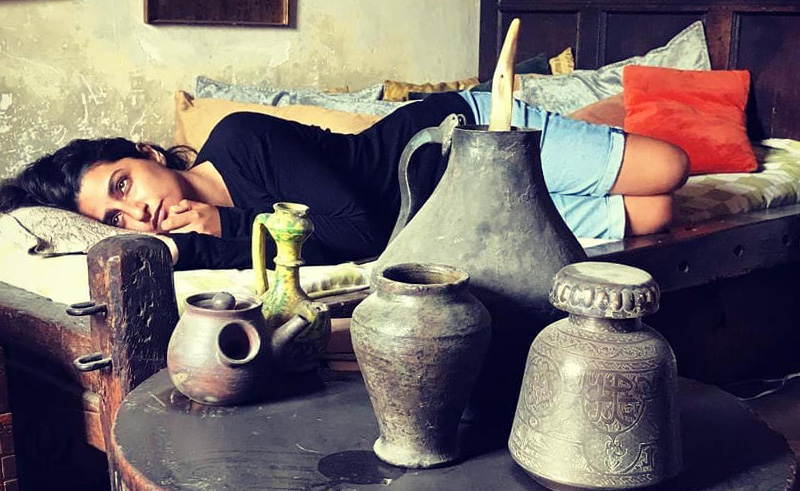 Your masterpiece ‘Nozhat El Nofos’ felt different from the music that was coming out at the time, yet uncannily close to the music of the era and, subtly, yourself. Can you tell us more about the research that you did for this project and your creative process?
Your masterpiece ‘Nozhat El Nofos’ felt different from the music that was coming out at the time, yet uncannily close to the music of the era and, subtly, yourself. Can you tell us more about the research that you did for this project and your creative process?
I was very lucky to meet Kamilya Jubran in Cairo when she came to perform and do a workshop. I took the workshop with her, and one of the projects was listening sessions. So, she played us songs from the 1920s. The first song was ‘Zoor Kabr El Habib’, which was an older version of Sayed Darwish’s ‘Zoroni Kul Sana Mara’, played by his mentor. When I was listening to it, it touched a place inside me that I didn’t know existed and I was trying to rely on my good ear and follow its maqam because it sounded very new and different. So, I went back from this workshop and I started obsessively listening to the songs from this era.
Listening to these love songs moved me so much, it was so amazing to discover that bold vulnerability and how love had a totally different way of expression before the censorship and standardisation. We don’t have that kind of love song now.
So, I found myself in this process of listening so much and realised that I need to listen to these songs with a bit of a fixed tempo—fixed in a way that is not wared or grided but just to fix the flow of the records to allow me to listen to them without going through bumps of tempo. And then, automatically, I started playing with it in my room. The first couple of years of working on record, I didn’t intend for it to be a project. Then, a friend of mine told me, “You quit your job and the bands and you are only doing this now. So, this is a project.”
I recorded most of the album in my room and I played most of the instruments. My brother and Wael El Sayed joined later. My approach was working with these archival sounds in a very genuine and honest way, discovering and just playing along without thinking too much about it. It was not about time or quality, but the kind of connection that happens with the material.
Throughout this project, I learnt about the 1919 situation and the music scene back then. I got to dig deeper into the singers’ voices, diaries, interviews, as well as the whole context, which is kind of similar to the time we are living in now, almost 100 years later.
And, the last couple of years before releasing, I was trying to find the right person to mix it, who was a sound engineer but also understood the emotional side of it more than the technicalities. I tried to get engineers to mix the record but they were trying to polish the sound, making it more clean and kind of merging music together in a way that would be good for the industry or to show the world.
Then, I found Adham Zidan, who I found to be the best fit for this because he also comes from a theatre background and he knew about dramaturgy and emotionality. He was also a composer and understood my approach, not just the standardisation of mixing and separating musicians in certain places. He dealt with the record as if he was part of the journey, which helped it sound they way it did in the end
What can you tell us about bringing back this archival material?
I don’t think I’m bringing back anything or doing any sort of restoration to these materials because honestly, it all started from a personal question of “Why am I getting bored?” and I found pleasure in this music. It was purely for selfish reasons, a kind of obsession with the music that grew into a project without me even realising it.
You’re currently working on a new project, ‘Solh’. Can you tell us more about it? How is it different and is it kind of taking your previous research about the power of sound and performance to a deeper level?
So, I had a lot of archival materials that I didn’t want to touch for a while and they were haunting me. Some were from the piece I did for the Museums of Lungs, which explores the healing rituals and funerals in African music heritage. It had a lot of microtonality and beautiful rhythms that I found kind of similar to Zaar. Also, other materials from a project I did with the Lebanese artist Tarek Afifi for the Moroccan musical rituals of El Ahwash, which was another way of celebrating death.
And, when I had a commission from EMPAC—The Experimental Media and Performing Arts Center—to work on something in very little time, they kind of asked, “What do you have at the moment?” and I was like, “Okay, I think I should start working with all these materials that have been piling up.” So, I started working on ‘Solh’.
It’s called ‘Solh’ because even when I had that resistance to work with these materials at the beginning, I figured out the similarities in the approach of doing rituals, so it is like a kind of reconciliation with birth, death, work, my ancestors and my body.
One of the main reasons I worked on this project was to explore how death was dealt with in the past and in different cultures because we have a very standardised way of dealing with things and emotions when there’s actually a bigger spectrum than that in different rituals.
It was very weird to work on it in the beginning because there was so much grief in these archives, which is related to things we don’t know how to navigate. Yet, it was also interesting that all these different rituals from all over the world, even though they don’t have the same microtonal aspect, didn’t need standardised tuning to come together as one piece in the end.
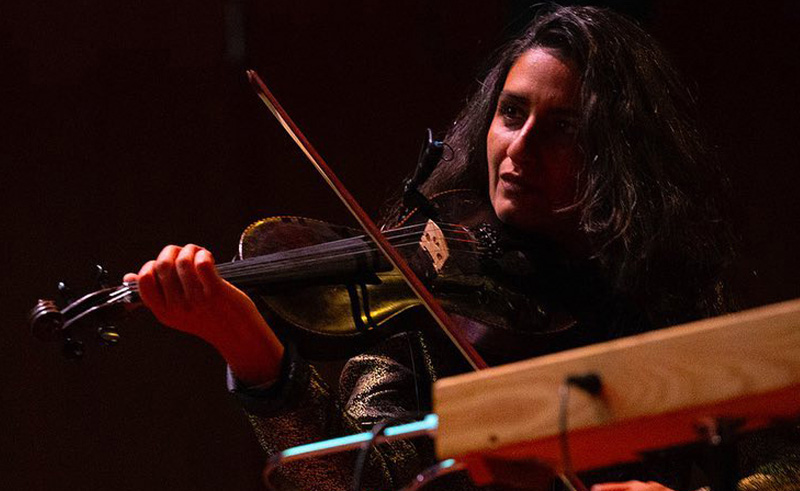 What is happening to this project right now? What stage is it in, and when can we experience the performance and recordings?
What is happening to this project right now? What stage is it in, and when can we experience the performance and recordings?
The project was originally composed for EMPAC to be played in an ambisonic system with 68 speakers. We did the first mix with 34 speakers. But, in Cairo, we kind of did it as an installation in April with only 12 speakers. Listening to it through a stereo or headphones never does feel right to me. I think that’s because in the process of making this piece, there were so many sounds that I either collected or recorded. We also recorded a compilation in an old church in Cairo, on El Asr El Einy Street. This part of the recording is in a totally different structure, it was like my own ritual to move on from all the other rituals and to kind of find my own sound after going through all the heaviness of all the evil and not-so-evil archives that were related to similar expeditions.
Right now, the project is in a phase, where I’m recovering from it a bit. But, it’s going to be released on vinyl, and on one side there is the recording we did in the church and on the other the installation that we did in Cairo.
Watch the full interview here:
- Previous Article Italian-Palestinian Duo No Input Debuts Eponymous Electro EP
- Next Article Music Commission Launches MusicAI for Global Music Education








